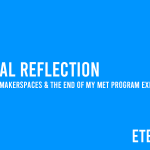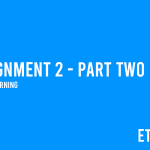Download PDF Version Following APA Guidelines
Flight Path
My name is Joseph Villella and I am in my final term of the MET Program. I will be a Grade 5/6/S.T.E.M. teacher next year. I have completed my Bachelor of Business Administration and an Associates Certificate in Web Technologies. This is my last term in the MET Program, and I am looking forward to using my new knowledge and skills with my students.
Prior to start ETEC 524, I hoped to gain skills and knowledge to create a S.T.E.M. Program at my school. I will be starting this program next year and recognize that the selection and design of learning technologies is important. This also tied into wanting to create more engaging lessons that will help my students across many different learning styles. I also felt like ETEC 524 aligns well with the constructivist approach to learning, which I had learned about it in ETEC 512 (Mcleod, 2023).
My goals coming into ETEC 524 included finding ways to create meaningful assessments, learn new technologies through discussions with peers, and just learning about new platforms and technologies in general. I believed that these goals would help me in teaching S.T.E.M. next year.
Course Experience
I had a positive experience during my time in ETEC 524 and was able to make progress towards my goals. Specifically, the assessment module in Week 6 helped me understand some of the weaknesses of my own assessments thanks to George Brown’s list (2001). I often fall into the trap of making assessments for the sake of needing an assessment, and then do not provide proper feedback to my students. I think this then also ties in with either unclear or unrealistic expectations I can sometimes have during these assessments. It was a great reminder to help me realize what an assessment should do and to focus what information I need to collect from it.
Mobile devices in the classroom is another topic that I feel that I took a lot from. Specifically, the article by Bai (2019) stating how it is important for technology and pedagogy to be merged for students to get the most out of education. In a high-school setting, many students have mobile devices, but they are not asked to utilize them to promote learning. This article really put that into perspective for me, as we should try to make sure of all technologies that enter the classroom.
Reading the article by Alexander (2014) really tied all the course content together for me. In his article, he showcased three distinct futures that we may reach based on current technological trends. I believe we have trended more towards the Renaissance future. We have hit a point where leading game developers and content creators are just as well known as actors and directors. Specifically, our curriculums focus a lot more on the creating a sharing of knowledge between students.
The connections that I have made with my peers has left a large impact on my thoughts about technology in education. To begin, the case studies helped me think about educational technologies in contexts which I was not familiar with. This gave me the opportunity to reflect and understand how these technologies can be used throughout the world, including in developing nations. The mobile technologies discussion post resonated with me the most, and specifically my interaction with Rylan. He shared his experiences in a school that allowed students to use mobile technologies as it was a way to enable gamified learning and access to the internet. I would have imagined that enabling students to use their device in an elementary classroom setting would mean students would become more distracted and be off task. However, Rylan explained that he did not notice students being off task more than in other situations where they were not allowed to use their devices. Instead, students were able to use these devices to access information easily and helped facilitate learning. It changed my thoughts on allowing these devices in an elementary setting.
Finally, I enjoyed the creation of my unit of learning on biomes and adaptations using Google Classroom. I learned more about instructional design and the universal design language guidelines (Cast, n.d.). It really helped me explore new technologies to find creative ways to reach my students through digital resources, assessments, and activities. Although I faced some challenges, I think I did a good job and would be confident creating more units in the future.
What’s Next?
As I reflect on my experiences in ETEC 524, I realize that there are many next steps for me to reach my goals as an educator through my usage of educational technology. I have learned a lot from this course, but I know that there will be even more opportunities for me to learn outside of the MET Program. The educational technology field always has more to learn and explore, so I plan to engage as a lifelong learner in many ways.
I hope to explore more technologies and platforms that can help me integrate my S.T.E.M. program at my school. I am interested in finding out more about learning management systems, gamified learning, and mobile technologies that can help promote collaboration in my classroom. The International Society for Technology in Education (ISTE) Standards for Educators (2017) is something that I will also keep in mind to ensure that I use my chosen technologies effectively and ethically.
I hope to revise and improve my assessments that I will use throughout the next year to make them more meaningful and aligned with the B.C. curriculum and competencies. I’ll use the criteria provided by Brown (2001) to assess my assessments and make changes where necessary. I also want to try to change some of my traditional assessments to encompass technology in meaningful ways, and I have some ideas how to do that thanks to the completion of my Assignment 2: Unit of Learning.
I also acknowledge that my educational journey does not end with this course or the MET Program overall. I plan on finding professional development opportunities to help strengthen my skills with educational technologies. This will help me provide better opportunities for my students to thrive and will also help me keep up with the latest trends and developments in the field. It will also provide me opportunities to network with teachers to share knowledge, and then apply it to improve my own classroom and school community.
I believe if I follow the above steps, I will be able to grow as an educator using educational technologies. I hope that these steps will help my students succeed and possibly inspire them to learn more about the educational technology field one day.
References
Alexander, B. (2014). Higher education in 2024: Glimpsing the future. Educause Review, 4(5). https://er.educause.edu/articles/2014/9/higher-education-in-2024-glimpsing-the-future
Bai, H. (2019). Pedagogical practices of mobile learning in K-12 and higher education settings. TechTrends, 63, 611–620. https://link.springer.com/article/10.1007/s11528-019-00419-w#Sec6
Brown, G. (2001). Assessment: A guide for lecturers (Vol. 3). York: LTSN generic centre.
Cast. (n.d.). The UDL Guidelines. https://udlguidelines.cast.org/
International Society for Technology in Education. (2017). ISTE Standards: Educators. https://www.iste.org/standards/iste-standards-for-teachers/
Mcleod, Saul. (2023). Constructivism learning theory & educational philosophy. https://www.simplypsychology.org/constructivism.html






